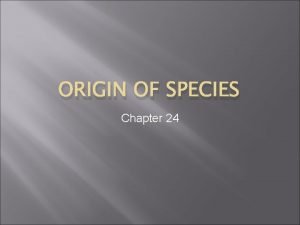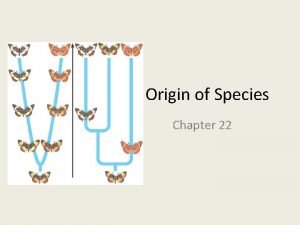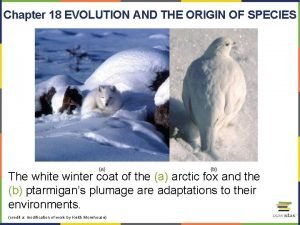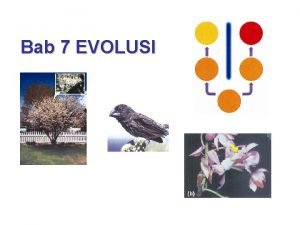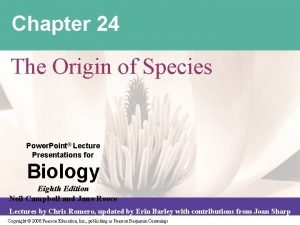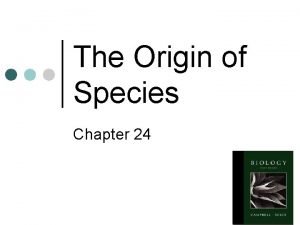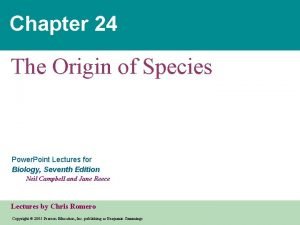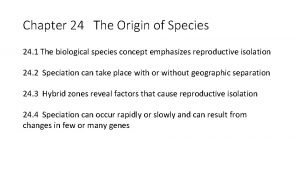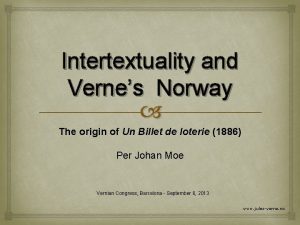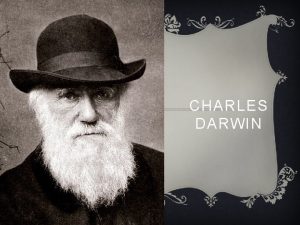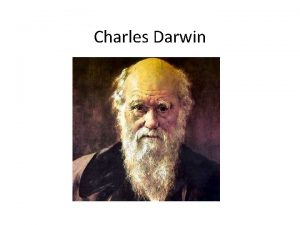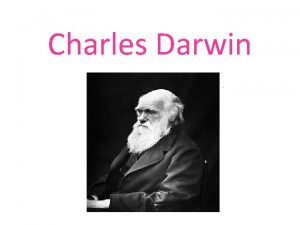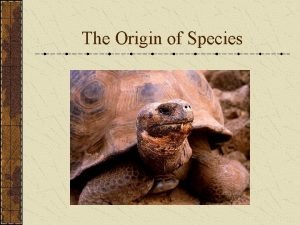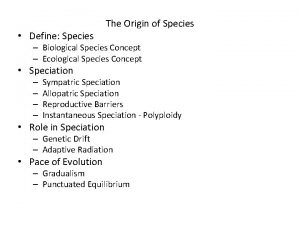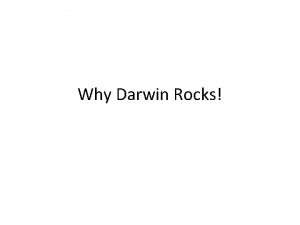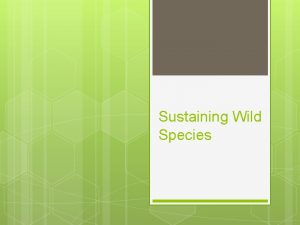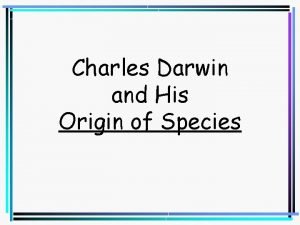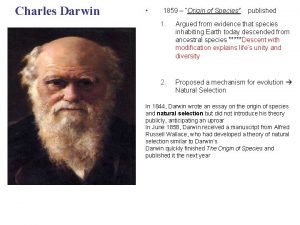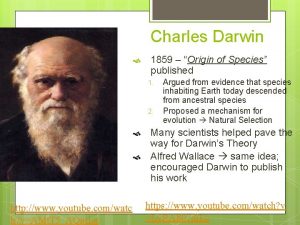Darwin Origin of the Species Why read Origin












- Slides: 12

Darwin Origin of the Species

Why read Origin? • Darwin’s Origin of the Species is seminal to the development of evolutionary thought. • Scientists generally agree that no one has influenced the modern scientific world view more than Darwin (Moore; Locke; Mayr) • Origin of the Species is still often referred to during the frequently contentious debates in parts of our nation concerning the appropriate ideas to be taught in public schools However, surprisingly, Moore cites Korey’s research that indicates few people have actually read the book. • • As further evidence, Moore states that “not one of the more than 500 students in [his] biology classes during the past four years has read it, ” and moreover, his polling of several scientists “suggests that no more than approximately one in ten biologists has read the book” (107).

Edition • We use the Oxford World Classic version of the text because it is based on Darwin’s second edition. • Darwin made several revisions between the first publication in 1859 and the sixth in 1872. • The later editions thus differ considerably from the first, and the last edition contains an additional chapter (chapter 7) dealing with objections to theory. • These changes tend to obscure the original argument. • The second edition was published just six weeks after the first edition, limiting Darwin to only a few revisions in the content of the original but allowing for the correction of some misprints.

Plethora of Details • Does Origin seem to drown you in details? • Darwin considered the book a brief treatment of the subject and initially planned a more complete work later on. • Even after over twenty years elapsing from the completion of his trip to South America to collect data in 1837 and the publication of Origins in 1859, he still was not quite ready to present his case. • However, he felt compelled to make some of it available to the public: “My work is nearly finished; but it will take me two or three more years to complete it, and as my health is far from strong, I have been urged to published this abstract” (3).

Structure of a Proposal Argument • Begins with an introduction that describes a problem and ends with a succinct statement of solution • A body section providing a detailed explanation of the solution • A body section that summarizes and rebuts opposing views • A justification section, in which the writer provides the reasons why the solution should be enacted. • The conclusion sums up the key points but also attempts to move the reader to accept the proposal

Are we imposing a structure of Darwin that he didn’t intend? • Locke asserts that "Darwin in his typical nineteenth‑century education would have been exposed to abundant examples from classical authors employing the pattern and indeed would have had training in the use. ” • “Darwin would have made use of such a pattern for his work, which he himself describes as ‘one long argument’” (Locke 89). • • This overview relies heavily on the discussions of Locke (87 89), Bowler (114 25), and Moore, but Bowler’s schema works better to illustrate Origin as a proposal argument than Locke’s (Locke restricts his analysis to the classical structure, leading him to note that chapters 10 14 are logically a digression, which “Cicero allows but rather disapproves of”; Bowler, on the other hand, suggests these chapters serve the necessary purpose of justifying Darwin’s argument).

Introduction to Origins • Darwin begins by describing the problem: although some naturalists may have concluded previously that “each species had not been independently created, . . . such a conclusion, even if well founded, would be unsatisfactory” unless a means could be found to account for how such changes could have occurred (4). • Then, after giving an overview of the book, he proposes his solution that species evolve as “lineal descendants of some other and generally extinct species” and that the process occurs through the mechanism of natural selection (7).

Explanation of His Solution Chapters 1 5 • Darwin devotes the first third of his book to his detailed explanation of his solution of the problem: species evolve through natural selection. • In the first chapter (“Variation under Domestication”), the author discusses the familiar success of animal and plant breeders in working with domesticated species (he gives particular attention to the breeding of pigeons, a very popular pastime in England at the time). His main point is that individual variation is due to artificial selection the breeder directly influences the reproductive process by changing conditions. • Then, moving to argument from analogy after establishing this commonly acknowledged fact, in the second chapter (“Variation under Nature”), Darwin argues individual variations also occur in the wild populations due to the “selection” of changing natural conditions. In this chapter Darwin also takes great pains to point out that naturalists often disagreed as to whether a particular form was a variety or a distinct species. This confusion, Darwin says, is easily done away with if we come to understand that varieties are merely an intermediate step in the production of new species. The term "species" is thus an arbitrary one: a species is just a strongly marked variety that the majority of experienced naturalists agree to call a species.

• From there Darwin transitions to the next chapter (“ 3: Struggle for Existence”), whose central concept was adapted from the "principle of population" that Malthus applied to human society. All species tend to over reproduce. When more individuals are born than can possibly survive, they must compete for the scarce resources necessary to keep themselves alive. • In the fourth chapter (“Natural Selection”), Darwin describes the mechanism of Natural Selection directly. In the struggle of individuals of a species for limited resources, a variation that makes one better able to exist within any changing conditions will enable that individual to survive and reproduce while the others of the species without that variation will die out. Thus, that individual will start a line of variant from the extinct original species, and after thousands of years of this process, what seems to be a new species will have emerged. • In "Laws of Variation" (chapter 5), he insists that although we may not know what has caused a variation, nonetheless all changes of structure result from a specific cause.

Responding to Opposing Views • • • In the middle third of the book (chapters 6 9), Darwin anticipates and responds to the many objections that will be raised against his theory. Here he acknowledges potential concerns about his theory, such as the apparent lack of transitional forms between known species, an explanation for species with peculiar habits or structures, its assumed inability to account for the production of organs of great complexity, like the eye (“Chapter 6: Difficulties on Theory"); its negation of Lamarck's claim that instinct is a learned habit that had been built into the species' hereditary con stitution (“Chapter 7: Instinct"); the failure of distinct spe cies, when crossed, to produce fertile offspring (“Chapter 8: Hybridization"); and the fossil record did not seem to support his concept that evolution always takes place slowly and gradually (“Chapter 9: On the Imperfection of the Geological Record"). To each of these issues, Dar win provides a detailed rebuttal (some even characterize it as tedious), replete with numerous examples from his and other naturalists’ observations

Justification of His Proposal • • • In the last third of the book (chapters 10 13), Darwin presents the justification for his proposed solution. He effectively argues that his theory of common descent by adaptive modification logically accounts for a wide range of otherwise inexplicable phenomena. Rather than disproving evolution, once we understand why the fossil record is imperfect, we realize that the known fossils are distributed just as we would expect on the basis of a theory of common descent (“Chapter 10: On the Geological Succession of Organic Beings"); the existence of unique groups of species can be understood in that rising and falling masses of land created routes for the dispersal of species and subsequent barriers to migration (“Chapter 11: Geographic Distri bution”); oceanic islands life such as the Galapagos were populated by birds, wind, and other natural forces carrying seeds and eggs occasionally across wide stretches of ocean (“Chapter 12: "Geographic Distri bution [Continued”]); and that phenomena which naturalists have difficulty classifying satisfactorily can be made explicable only in terms of a theory of common descent, that the fact that the embryos of different animals often show a much greater degree of resemblance than the adults can be explained on the assumption that adaptive modifications are produced mostly by changes in the later stages of growth, leaving the early pattern of development unchanged, and that the existence of rudimentary or atrophied organs, which are of no apparent use and which often never develop beyond a vestigial stage, can be explained adequately only in that they are relics of once useful structures, now declining because the changing habits of the species have rendered them superfluous (“Chapter 13: Mutual Affinities of Organic Beings; Morphology: Em bryology: Rudimentary Organs").

Origin’s Conclusion • Darwin uses his final chapter (“ 14: Recapitulation and Conclusions") to sum up his entire argument. • In the final paragraph, he uses the metaphor of the "tangled bank" to describe the complex interrelations of all of life and then ends the book with his assertion of the "grandeur of this view”: “life, . . . having been originally breathed by the Creator into a few forms or into one; and. . . from so simple a beginning endless forms most beautiful and most wonderful have been, and are being, evolved” (396).
 Origin of species by charles darwin
Origin of species by charles darwin Andreas carlsson bye bye bye
Andreas carlsson bye bye bye A keystone
A keystone The origin of species ch 1 manga
The origin of species ch 1 manga Example of biological species
Example of biological species The origin of species - chapter 22
The origin of species - chapter 22 The origin of species manga chapter 18
The origin of species manga chapter 18 Percobaan spallanzani
Percobaan spallanzani The origin of species chapter 24
The origin of species chapter 24 Temporal isolation
Temporal isolation The origin of species chapter 24
The origin of species chapter 24 The origin of species manga 24
The origin of species manga 24 The origin of species bl novel
The origin of species bl novel




